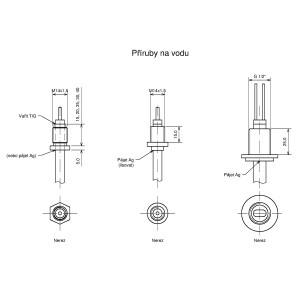Heating liquids
In practice, this mostly concerns heating of water and oils.
Information required to determine the wattage of the heating elements for heating of liquids:
- Specification of liquids.
- Volume and potential speed of the flow of liquids.
- Starting and target temperature.
- Information concerning the insulation of the tank and ambient temperature.
- Time required for heating.
The liquid must be specified as precisely as possible for the purpose of determining the maximum possible watt density of the rod (W/cm2) and for determining the materials used in the sheath of the rod. For heating of water, it must be stated whether it will be heated to the boiling temperature (e.g. elements for developing steam) and the type of water (from water piping, demineralised water, water with added washing chemicals, pool chemicals, dishwasher chemicals or other chemicals). In the case of water solutions, the concentration of the solution must be specified. In the case of water and water solutions, due to the risk of galvanic corrosion, the material of the tank must be stated.
In cases of heating of oil, the working temperatures it is designated for must be specified.
For the design of the specific form of the heating element, it is also necessary to state the dimensions of the tank and to define the space for the heating element, the required length of the no-heating zone of the element, the place designated for fixing the heating element, the space for the terminal box and any other restricting factors.
Where possible, it is preferred to locate the elements at the bottom of the tanks.
Consider if the thermostat, heating fuse, or another type of regulation is to be part of the element.
It is also important to define the environment and restricting factors in the place of electric termination (e.g. vibrations, humidity, risk of mechanical damage, risk of contamination by liquids, explosive character of the environment, etc.).
You can see the most frequently used elements for heating of liquids in our catalogue:
![]() Catalogue of elements for heating of liquids.
Catalogue of elements for heating of liquids.
Typical maximum watt density of heating rods:
| Static water in tanks | 10 W/cm2 |
| Water in washing machines (swirled) | 14 W/cm2 |
| Flowing water | 25 W/cm2 |
| Developing steam | 6 W/cm2 |
| Heating of water under pressure (up to 3.5 MPa) | 6 W/cm2 |
| Oil | 0.8-7.7 W/cm2 – according to the type of oil |
| Petrol, kerosene | 3.5 W/cm2 |
| Wax, paraffin | 2.4 W/cm2 |
| Molasses | 0.6 W/cm2 |
In the case of heating other liquids, the maximum usable values of watt density of the heating rods are stated according to the specific task.
For more information or help to resolve specific heating issues, please contact us.
Sheath materials
- Copper
- AISI 321
- AISI 304
- AISI 316L
- AISI 316Ti
- ALLOY 825
- INCOLOY 800
- Steel 11 353
What type of heater do you need?
Tubular heating elements
Due to the price and shape variability, this is the most frequently used technology in heating rods for heating liquids.
Flat tubular heating elements
These are used in situations where it is necessary to achieve maximum lowest watt density (W/cm2), e.g. heating of honey, wax, various oils or in situations where this rod is suitable due to other design reasons (small dimensions, leads on one side, rods, etc.).
Cartridge heaters
High-performance cartridge heaters – are used in external conditions where other types of rods with insulation have an unacceptable service life or there is insufficient space for them. A further use is for the indirect heating of liquids where the cartridge is located in a protective sheath resistant to problematic liquids.
Medium and low loaded cartridge heaters – these are used in some cases due to design reasons (e.g. length of the rods, the requirement to fit a heating fuse directly into the heating rod, etc.).
Band heaters
Band heaters are used in situations where the heating of liquids in piping is required.
Elements with open wire
Ceramic heating elements are used for the indirect heating of liquids in applications where directly heating liquid is complicated or impossible (the heating rod is dipped in the liquid), e.g. in a galvanic bath or for heating too hard water. The element is located in the protective sheath (mostly in the tubular) which is from material resistant to the aggressive liquid (e.g. ceramics, titanium, glass, etc.).
Flat mica elements
As a standard, these are not used for heating liquids.
